All products featured are independently chosen by us. However, SoundGuys may receive a commission on orders placed through its retail links. See our ethics statement.
What is distortion?
Published onNovember 24, 2021
Audio distortion is a term most people are familiar with, largely thanks to Jimi Hendrix, Eddie Van Halen, and everyone who has attempted to imitate them by turning their amplifiers up to 11. But what is distortion, what causes it, and why is it the enemy of audiophiles?
People can usually recognize audible distortion, although it manifests in different ways. Distortion ranges from subtle, barely perceptible coloration to faint “fuzz” to a nasty buzzing on certain notes or frequencies — it can get so bad as to make it sound like something is really broken. More often than not, distortion creeps in as we turn up the volume, and there are reasons for that.
How do you define distortion?
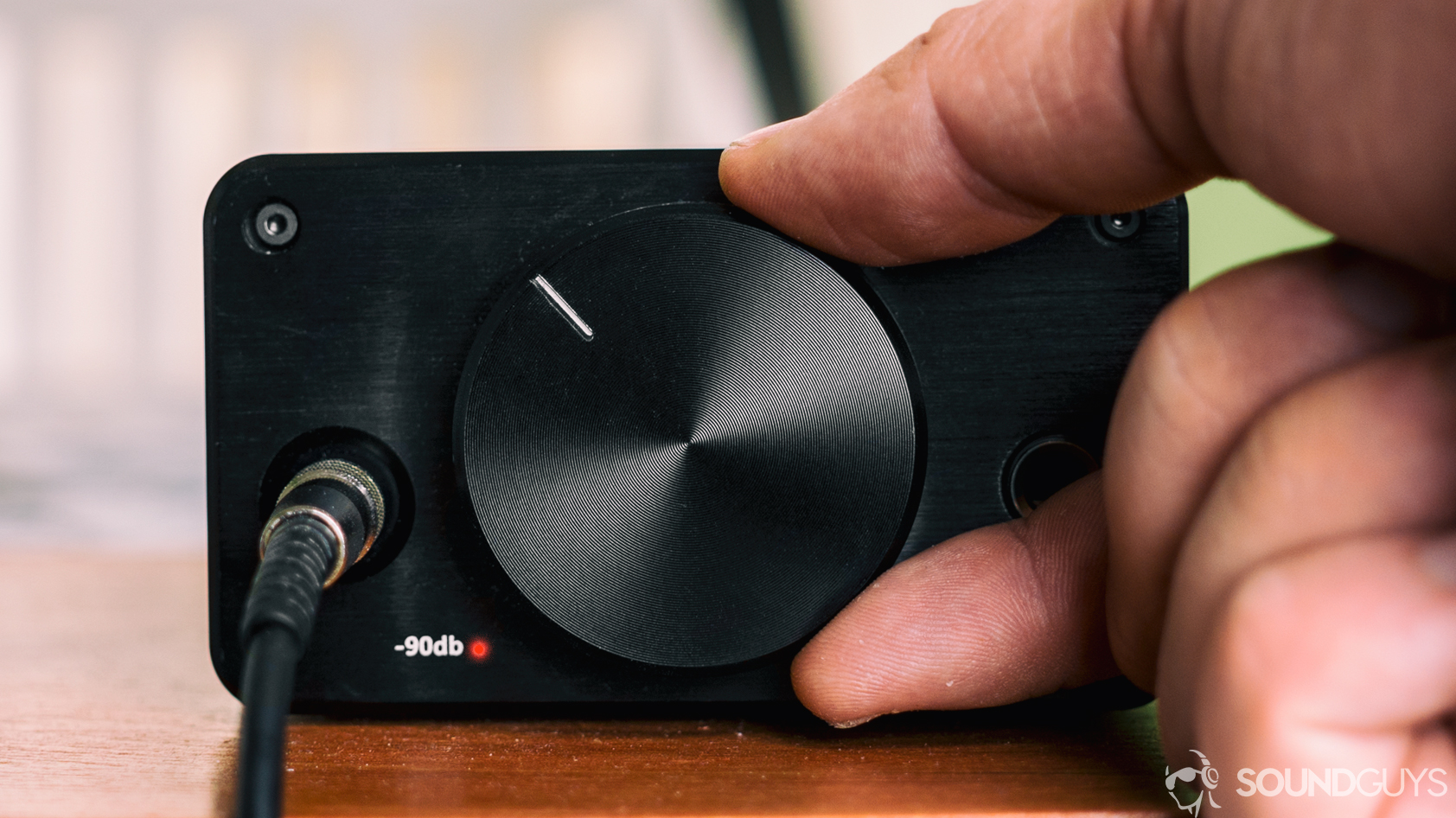
First, let’s define what we mean by distortion in general terms:
- Distortion changes the shape of the audio waveform, meaning the output is different from the input.
- If a single frequency (a test tone) is played into a system, and the output consists of multiple frequencies, there is non-linear distortion.
- If any output does not scale with the input signal level applied, it is noise, and we consider that separately from distortion.
Audio signals get distorted in much the same way an image gets distorted when it passes through a dirty or broken lens or when the image is saturated or “blown out.” Distortion can occur in both recording and playback at multiple points in the audio signal chain.
What causes distortion?
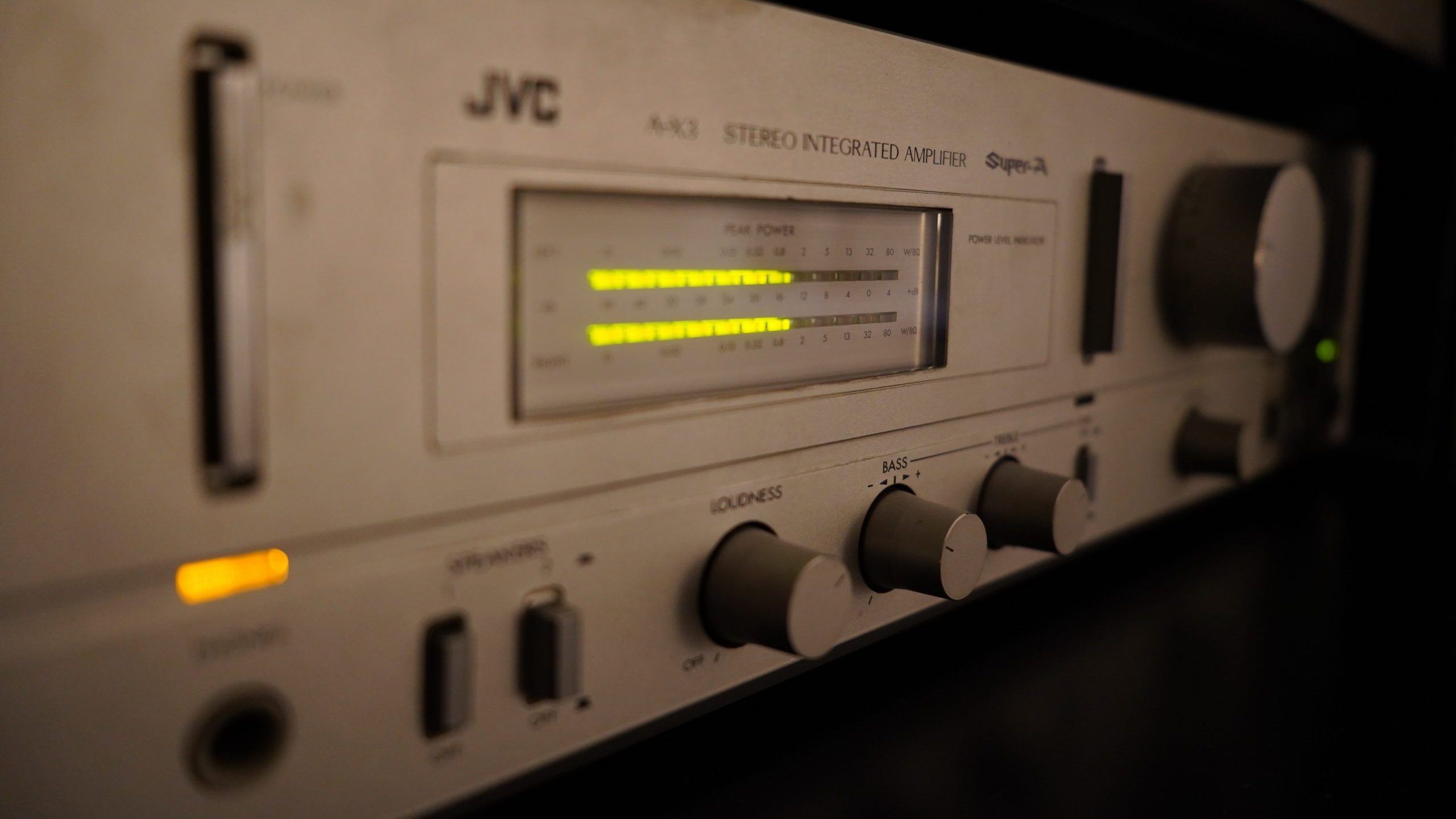
A signal distorts when an audio device’s output doesn’t track the input with perfect accuracy. The purely electronic components of our signal chain (amplifiers, DACs) tend to be far more accurate than the electro-acoustic components, known as transducers. Transducers convert electrical signals to mechanical movement to create sound, like a loudspeaker—or vice versa, like a microphone. Transducers’ moving parts and magnetic elements typically become non-linear outside of a narrow operating range. However, pushing electronics to amplify a signal beyond their capabilities can quickly sound bad.
Distortion is used creatively in music production, but that is a whole subject in itself. We’re focusing on distortion in audio reproduction—otherwise known as the playback path—meaning how you listen over speakers or headphones. For accurate sound reproduction, which is the primary goal of HiFi products, all distortion is considered bad, and equipment manufacturers aim to eliminate as much of it as possible.
How is distortion quantified?

Our input signal is the piece of audio we want to play, also known as the “program material” — at least, it would be if we were to describe any distortion that might be present subjectively. At SoundGuys, however, we’re in the business of avoiding subjective descriptions when good objective metrics exist. We are going to make objective measurements!
When we want to characterize audio systems, we use test tones (aka sinusoids) or sinusoidal sweeps. These are simple audio signals made up of sine waves at defined frequencies. Alone, test tones do not sound musical but are actually the basic building blocks of all complex, musical waveforms and allow us to create accurate, repeatable, and standardized tests. With test tones, we can more effectively observe and describe the nature of any signal distortion our device produces during a test.
What is linear distortion?
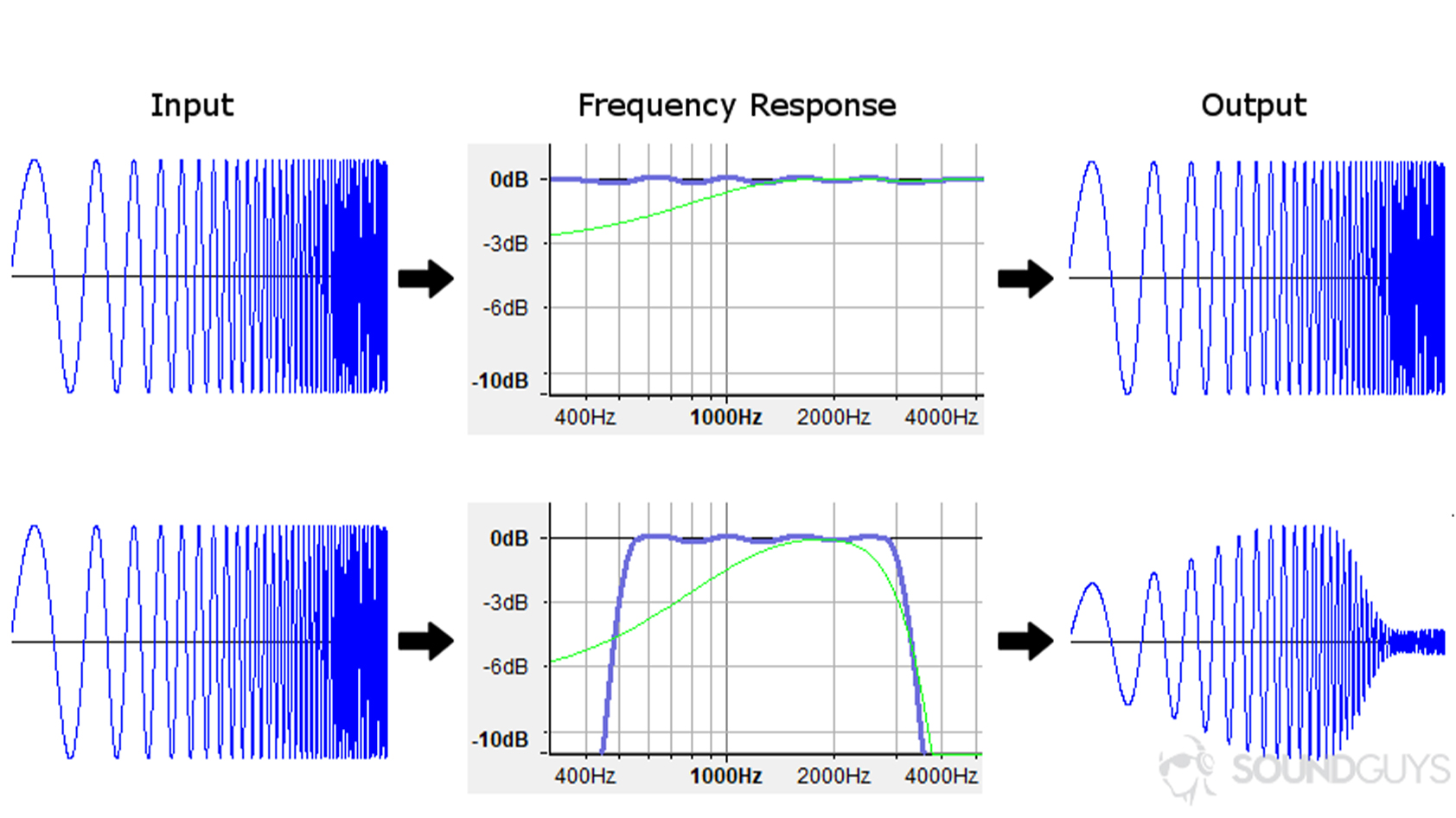
Strictly speaking, any device that doesn’t have a perfectly flat frequency response produces linear distortion. This type of signal distortion prevents the original spectral content of the signal from being faithfully reproduced. An ideal frequency response is typically considered a flat line with no linear distortion. However, remember that the ideal response may not be a flat line, depending upon the device’s intended application.
It is also possible to change the shape of the audio waveform without modifying frequency content by distorting the relative timing of the arrival of different frequencies (this happens in passive loudspeaker crossovers, for example). You can use square waves to test for this, as changes to their shape reveal timing errors, and looking at the waveform quickly identifies problems. Phase vs frequency plots can also show this timing distortion. Ideal devices that do not introduce phase or timing errors are called linear phase.
What is non-linear distortion?
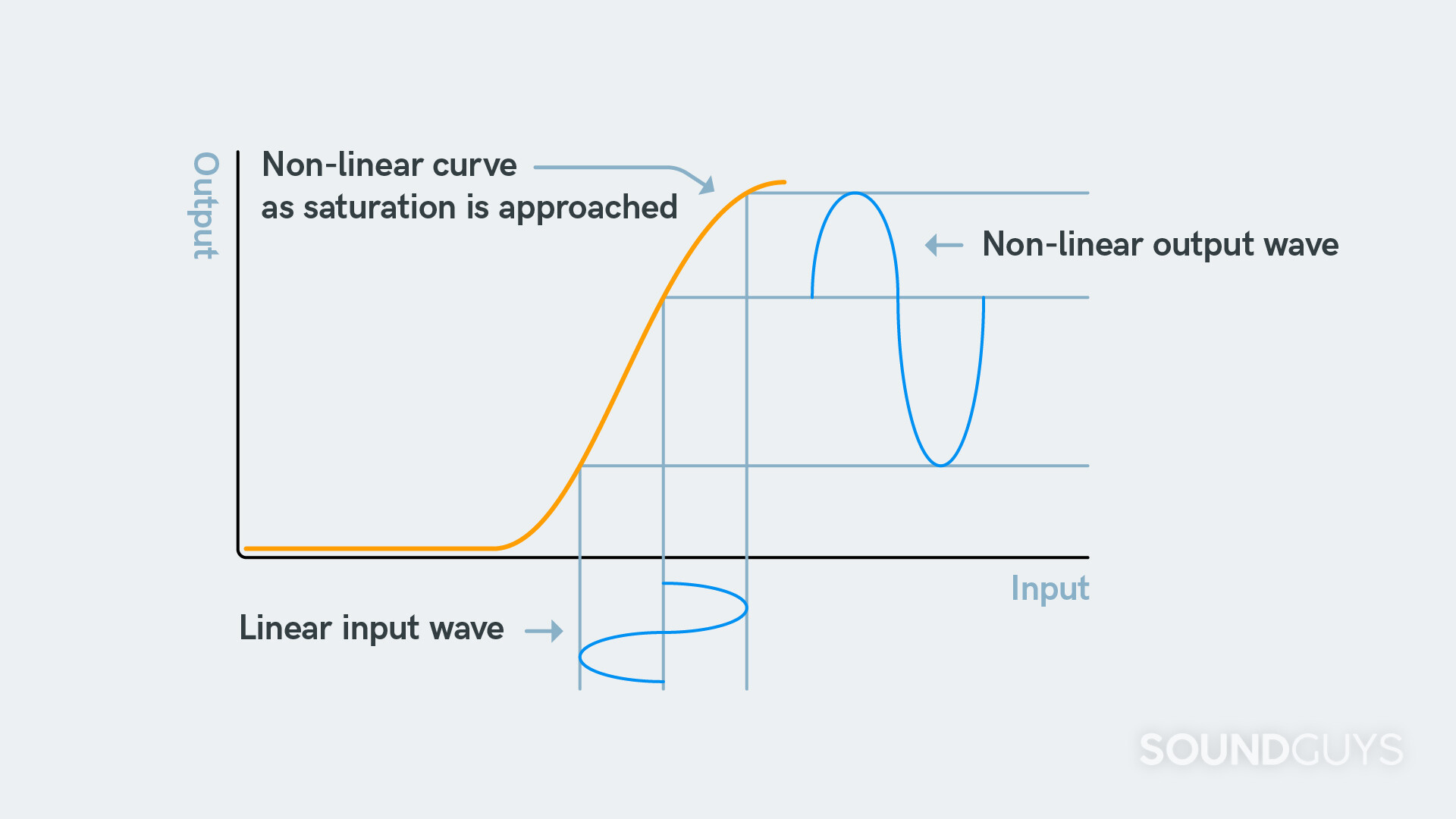
A perfect sine wave consists of only one frequency, though real devices produce non-linearities that add harmonics and distort the signal either a little or a lot. Non-linearities are inherent in devices that have an input-output characteristic that isn’t a straight line (e.g., the illustration above). Harmonic distortion is the addition of new tones to the audio signal. These distortion products occur at integer multiples of the original signal’s frequency and are harmonically related to the original tone. When the signal is a single sine wave (tone) of frequency f1, harmonic tones are f2, f3, etc., at integral multiples of the original tone.
For example, a 1kHz fundamental signal subjected to non-linear distortion will produce energy at 2kHz: the second harmonic, 3kHz (the third harmonic), 4kHz (the fourth harmonic), and so on.
What is THD?
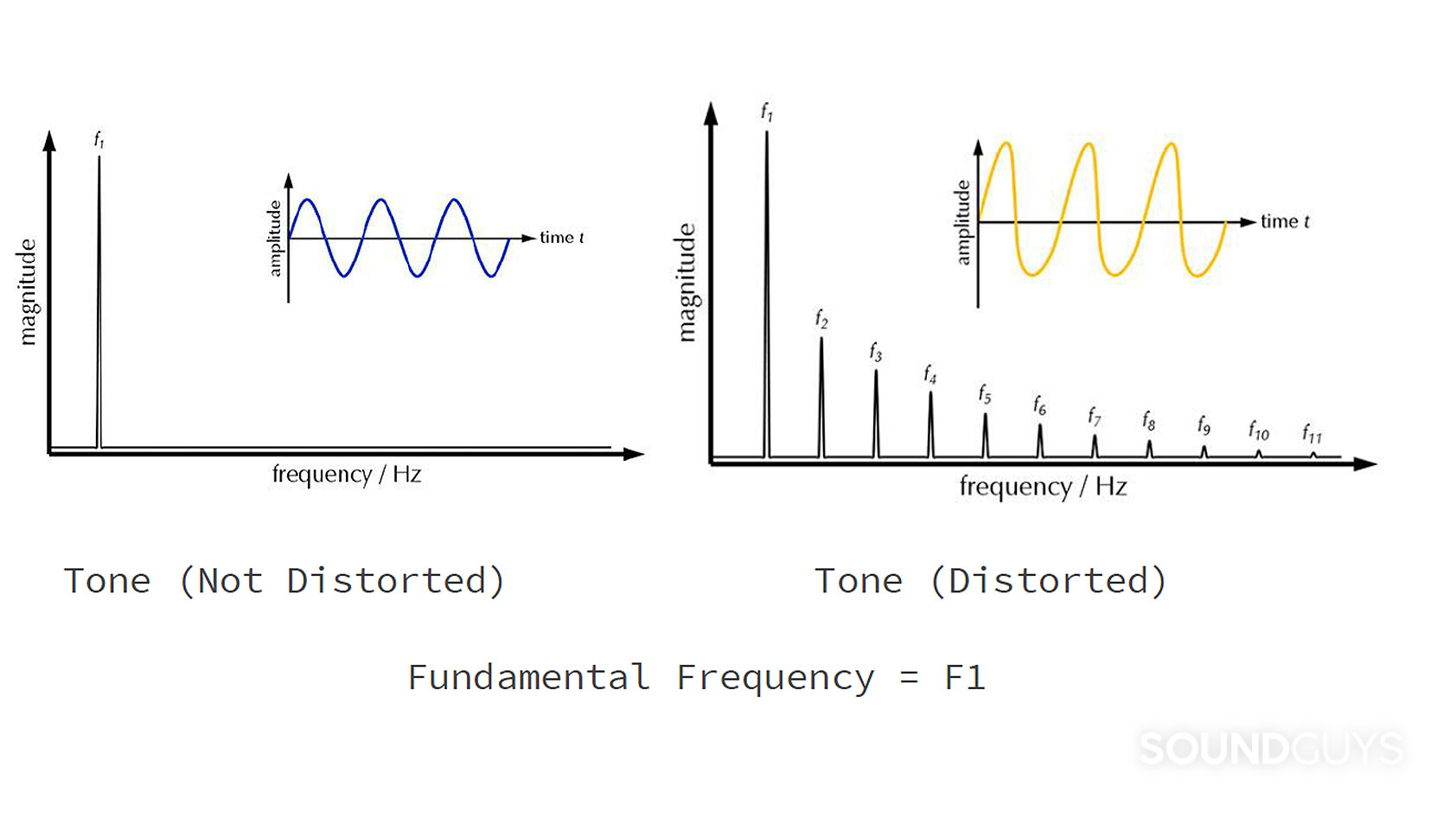
Total harmonic distortion (THD) is the sum of all the harmonics measured in the product’s output. A THD measurement sums all the distortion products by adding up the extra harmonic energy into a single value, expressed as either a percentage (which we’ll typically show on a logarithmic scale) or as a dB value, representing the proportion of the energy compared to the fundamental or desired signal. The THD ratio will be a percentage value of less than 100% or a negative decibel value. For example, 1% THD is equivalent to -42 dB, and 89% THD is -1 dB. When making these measurements, the analyzer must have a significantly lower THD than the device under test.
Here’s a video where you can hear the effect of increasing amounts of THD applied to music and test tones.
THD is the most common distortion metric you will come across. The terms THD and distortion are often used interchangeably, although that’s an oversimplification, as many types of distortion exist.
How do typical headphones measure for THD?
Below are some real-life examples of THD measured on headphones using our acoustic test head. As you can see, the results are plotted on a graph with a logarithmic frequency scale on the x-axis, just like a frequency response chart.
Here is an example consisting of two different in-ear headphone products from Sennheiser (IE 300, IE 900), which appear to have quite similar performance based on their frequency responses:
However, the % Total Harmonic Distortion plots for these same products show us that the product engineers have made the IE 900 better by decreasing the non-linear distortion it produces.
Why doesn’t SoundGuys provide THD graphs for every product?
Although our standard headphone test provides information about many performance parameters, including distortion, we only publish some of the data we collect. We rarely talk about THD in our headphone reviews for two reasons:
- Measured THD doesn’t appear to correlate particularly with our reviewers’ subjective impressions.
- It is rare to find commercially available headphones where harmonic distortion is an issue worth paying attention to.
We don’t include all of our measured data to keep our reviews as focused as possible on what you need to know without adding unnecessary detail — or fodder for misunderstanding. This means you’re getting the distilled version of a product’s performance data, curated by our audio experts.
Multi-Dimensional Audio Quality Scores (MDAQS)
Newer reviews on this site include data produced by MDAQS from HEAD acoustics, a cutting-edge audio playback assessment technique encompassing advanced research into the human perception of sound quality. It simplifies the characterization of audio systems by producing three mean opinion scores plus an overall quality rating. One of the primary attributes that MDAQS provides is distortion, but it is essential to point out that while it does include a calculation of THD, the MOS-D score presented also considers frequency response, non-linearities, and modulation spectra. Since they have been shown to align well with the subjective audio quality ranking of human listeners, we are confident in providing these scores as part of our assessment of products. You can read more about MDAQS here.